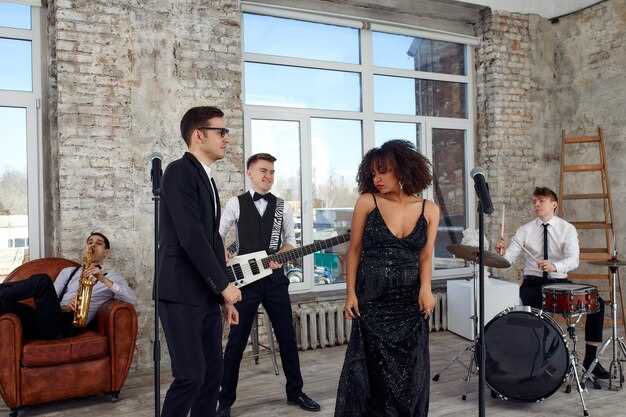Start by assessing the type of corporate event you’re organizing. A product launch requires upbeat and energizing tunes to maintain excitement, while a networking event benefits from soft background music that encourages conversation. Understand the goal of the event, and align the music accordingly to enhance the atmosphere.
Next, tailor your playlist to the audience demographics. Consider the age group, cultural background, and industry of your attendees. Younger crowds may appreciate contemporary hits, while a more mature audience might prefer classic tracks. Balancing the preferences ensures that everyone feels comfortable and engaged throughout the event.
Seamless progression between tracks is key. Start with gentler melodies during arrival and transitions, then amplify the rhythm as the event progresses. Respect the natural flow from one segment of the event to another with appropriate music transitions. This not only maintains guest interest but enhances the overall experience.
Where available, leverage live music to add a unique touch. A jazz band or acoustic guitarist can offer an engaging spectacle and set a memorable tone. Evaluate the venue space and budget constraints to determine the feasibility of live performance. If the budget or space is limited, a skilled DJ can adapt the playlist on the fly to match the mood.
Lastly, never underestimate the power of volume control. Too loud and you’ll stifle conversations; too soft, and it might get lost in crowd chatter. Adjust volume levels according to the event phase–the music should be audible yet allow guests to comfortably interact with each other.
Selecting the Right Music Style for Your Corporate Event

Identify your event’s theme and purpose, as this directly influences your music choice. A sophisticated gala might benefit from a jazz ensemble, offering smooth and elegant tunes that accentuate the event’s formal atmosphere. In contrast, a tech conference could benefit from ambient electronic music that maintains energy levels without overwhelming conversations.
Understand the demographic profile of your attendees. If you anticipate a younger crowd, consider contemporary hits played by a live band or DJ, focusing on popular genres they resonate with. For a diverse group spanning various age ranges, opt for classics that bring nostalgia and familiarity.
Consider the venue and its acoustics. An outdoor setting might require lively acoustic performances that engage guests without requiring heavy equipment. Indoor settings, especially those with excellent sound systems, allow for a broader range of musical styles from orchestras to indie bands, ensuring high-quality sound.
Plan for the event’s progression. Begin with softer background music during arrivals and networking time. Transition into more upbeat selections as the event moves towards any presentations or speeches, followed by lively tunes to energize guests during breaks or post-event receptions.
Don’t forget to account for any cultural or regional preferences, particularly if your corporation has a global presence or your audience is culturally diverse. Integrating music that reflects diverse backgrounds can make your event more inclusive and enjoyable for everyone.
Understanding the Audience Demographics
Identify the age group of your attendees first. Younger professionals might appreciate more current pop hits and energetic electronic tunes, while older participants could favor classic rock or timeless jazz standards. Considering generational preferences ensures your music resonates well with everyone in attendance.
Next, gauge the cultural and regional background of your audience. A diverse group might enjoy an eclectic mix of global music, incorporating genres such as Latin, reggae, or K-pop, which can break the ice and boost engagement. On the other hand, a more homogenous crowd might prefer local or mainstream tracks that align with their shared experiences.
It’s also important to assess the professional hierarchy and industry of your guests. Senior executives at a formal event might lean toward sophisticated instrumental selections, while a more casual start-up environment could thrive with indie or alternative music that reflects a relaxed culture.
| Demographic Aspect | Music Recommendation |
|---|---|
| Age Group | Pop, Rock, Jazz |
| Cultural Background | Global Tunes, Local Hits |
| Industry Type | Instrumentals, Indie |
Finally, survey attendees in advance or during registration to gather insights into their music preferences. This proactive approach allows you to tailor the playlist according to real data, enhancing satisfaction and creating a memorable atmosphere.
Aligning Music Choices with Event Goals
Prioritize understanding the primary purpose of your corporate event. Whether it’s launching a new product, enhancing team morale, or cultivating client relationships, the music should reflect and support these objectives.
For product launches, opt for energetic and uplifting tunes to excite participants and invoke a sense of innovation. Genres like pop and electronic can effectively set an enthusiastic tone.
For team-building events, choose music that encourages collaboration and enjoyment. Light, upbeat tracks that foster a relaxed and positive atmosphere can boost interactions and camaraderie.
In client-focused gatherings, consider classical or jazz as a background choice. These genres create a sophisticated ambiance, allowing conversation to flow without distraction.
Always consider the demographics of your attendees. Customizing playlists to resonate with their preferences enhances engagement and satisfaction.
Gather feedback post-event to assess the music’s impact. Attendee insights can provide valuable guidance for future events, ensuring music choices consistently align with goals.
Incorporating Company Culture into Music Selection
Begin by aligning musical choices with the company’s core values and identity. If your organization emphasizes innovation, explore genres like electronic or indie that mirror an avant-garde spirit. For those with a heritage focus, classic or instrumental tracks can resonate well. Cultural diversity within the team offers a wonderful opportunity to include music that represents various backgrounds, promoting inclusiveness. Engage employees in the music selection process through surveys or suggestion boxes, fostering a sense of community and ownership. Also, consider the event’s purpose–whether it’s a celebration, a formal gathering, or team building–ensuring the music complements the desired atmosphere. Regularly update playlists to reflect current employee preferences and cultural trends within the organization. Always test your selection with a small group to gauge reactions and ensure your choices enhance the event’s goals while staying true to the company’s ethos.
Considering the Venue Acoustics and Theme
Begin by evaluating the acoustics of your event venue to ensure optimal sound quality. Different spaces can dramatically alter the way music is perceived. A venue with high ceilings and hard surfaces might cause echo, while a carpeted, low-ceiling room could muffle the sound. Tailor your music selection to suit these conditions. For larger venues, opt for soundscapes that fill the space without overwhelming it. In more intimate settings, consider acoustic sets or a string quartet for a cohesive auditory experience.
- Assess the Acoustics: Visit the location beforehand. Clap your hands to gauge the sound reflection or consult an audio specialist for insights. This can guide whether you need additional sound equipment or specific types of instruments.
- Match the Theme: Music should complement the event theme. For a vintage-style gathering, swing or jazz might enhance the ambiance. A tech-focused event may benefit from electronic or modern instrumental pieces. Creating a playlist that mirrors the event’s mood fosters a seamless experience for attendees.
- Consider the Audience: Tune into the preferences of your guests. For a multicultural audience, a blend of genres might appeal to diverse tastes. Ensure inclusivity by incorporating well-known hits across eras and genres if appropriating the event.
- Check Equipment Needs: Determine if the venue has existing sound systems and assess their quality. If necessary, collaborate with sound technicians to bring in additional equipment that guarantees the music’s impact is maximized without distortion.
Align the music with both the physical and thematic elements of your event for a memorable and engaging atmosphere. Consistent auditory cues enhance the event’s narrative and resonate well with attendees, leaving a lasting impression.
Practical Considerations When Planning Corporate Event Music

Start by defining the event’s purpose and the audience profile. Tailor music selections to match the event’s mood, whether it’s a relaxed networking event or a formal awards ceremony.
- Venue Acoustics: Assess the venue’s acoustics and constraints. Large spaces may require more powerful sound systems, while smaller venues might benefit from acoustic performances to avoid overwhelming guests.
- Music Style and Genre: Choose genres that align with the event’s theme. For an international clientele, incorporate diverse musical styles that respect cultural preferences without alienating any group.
- Volume and Sound Levels: Maintain a moderate volume to allow conversation while providing an engaging atmosphere. Pre-test sound levels to prevent disruptions during speeches or presentations.
- Live Music vs. DJ: Consider live bands for interactive and immersive experiences, or opt for a DJ for a more versatile range of music selections throughout the event.
- Timing and Schedule: Plan music transitions to complement the event schedule. Play softer music during dinners and more upbeat tracks during networking sessions or after-parties.
- Licensing and Legal Needs: Verify music licensing requirements to avoid legal complications. Whether streaming or hiring musicians, ensure compliance with all necessary regulations.
The right music choice can enhance the event’s atmosphere and leave a lasting impression on attendees, so take the time to make informed decisions.
Setting a Realistic Budget for Music
Establish your music budget by first determining the scope of your event. Consider the number of guests, the event duration, and the venue size. These factors will significantly influence the cost of hiring musicians or a DJ. Then allocate approximately 10% of your total event budget to music, ensuring you leave room for unexpected expenses.
Research average pricing for musicians and DJs in your area to set a baseline. DJs might charge hourly rates ranging from $500 to $1500, while live bands can cost from $2000 to $5000 depending on the number of members and their experience. Contact several performers to get quotes, and do not hesitate to ask for package deals or discounts.
Consider season and day factors as they significantly affect pricing. Booking entertainment during peak seasons or weekends will be costlier. A midweek event might afford you better rates and more availability. Flexibility with dates can lead to considerable savings.
Account for additional costs such as transportation, accommodation (if needed), and audio equipment rentals. These can inflate your budget if not planned for in advance.
Prioritize quality over quantity. A talented DJ or a smaller, high-quality band can provide a more memorable experience than a larger, mediocre ensemble. Ask for samples of their work or attend a live performance to ensure their style matches your event’s theme.
Lastly, review your contract carefully before committing. Confirm the duration of their performance, set-up requirements, and any overtime charges. Clear agreements prevent misunderstandings and ensure your event runs smoothly within budget.
Live Band vs. DJ: Choosing Based on Event Needs
Determine the atmosphere you aim to create. A live band delivers authenticity and a personal touch, making it ideal for gala dinners or upscale networking events seeking an elegant ambiance. With their ability to interact with guests and adjust setlists on the fly, bands add a dynamic element perfect for impressing attendees.
On the flip side, if your event plans include a modern vibe or require a seamless flow between various music genres, a DJ may be the better choice. DJs offer a diverse music selection and can easily transition between songs, keeping energy levels high for club-like settings or product launches where a contemporary feel is key.
Consider the acoustics and space of the venue. Live bands generally require more room and have specific sound requirements. Ensure your venue can accommodate the ensemble’s needs, including stage size and electrical setups. DJs often require less space and are adaptable to various locations, making them suitable for smaller venues or flexible event layouts.
Think about the budget implications. Live bands typically involve multiple musicians, making them a pricier option. However, the unique experience they provide can justify the cost if entertainment is your top priority. DJs tend to be more cost-effective and can fit within tighter budgets, delivering great value without compromising on music quality.
Align the choice with your audience’s preferences. Engage with potential attendees or look over guest demographics to gauge their musical tastes. A younger crowd might resonate better with a DJ’s set, while a mature audience may appreciate the sophistication of a live band.
Developing a Playlist That Complements the Event Schedule
Start by aligning your music selection with the event’s timeline. For instance, welcoming guests can be enhanced with light, ambient tunes that encourage mingling. Consider genres like jazz, acoustic, or soft pop to maintain a pleasant atmosphere as attendees arrive.
As you transition to presentations or speeches, select instrumental tracks or subtle background music that won’t distract from the speakers. This approach helps maintain focus while adding a professional touch.
Deploy upbeat and lively music during breaks and networking sessions to re-energize participants and facilitate conversations. Genres such as indie pop or classic hits often work well, creating a relaxed and friendly vibe.
For meals, choose soothing music that complements dining without overwhelming conversation. Options like classical or light electronic can create an elegant backdrop.
As the event approaches closing, boost the energy with dynamic tracks if the schedule permits. This leaves attendees with a lasting, upbeat impression. Curate selections from popular, feel-good songs or throwback hits that resonate universally.
Maintain flexibility by having several optional tracks ready to adapt to any timing changes. Tailoring the playlist to coincide with the event flow fosters a harmonious atmosphere and enhances the overall experience.
Coordinating with Event Planners and AV Teams
Establish direct communication with both event planners and AV teams at the earliest stages to ensure alignment on the event’s vision and technical requirements. Share a detailed playlist proposal, discussing the proposed genres, tempos, and any specific tracks to get collective feedback. This ensures the chosen music complements the event’s atmosphere, theme, and objectives seamlessly.
Schedule a meeting with the AV team to review the venue’s acoustic characteristics and the available sound equipment. It helps in making necessary adjustments to the playlist based on the sound system’s capabilities, ensuring quality audio throughout the event. Ask about options for integrating live music or DJs if required, to enhance engagement.
Address any technical limitations, such as power supply adequacy or space constraints, that may affect the musical setup. Collaborating closely with the AV team also facilitates swift troubleshooting if technical issues arise during the event.
Maintain open lines of communication with event planners, especially for last-minute changes, ensuring the music plan adapts swiftly to any shift in event logistics. This proactive coordination ensures a smooth and enjoyable experience for all guests, highlighting the importance of synchronization between music, event planning, and AV operations.
Video:

Corporate Event Musicians – A Music & Events
Corporate Event Musicians – A Music & Events
Q&A:

How can I determine the best type of music for a specific corporate event?
To choose the ideal music for a corporate event, consider the event’s purpose, theme, and audience. A formal meeting might benefit from classical or instrumental tracks to keep focus, while a networking event could thrive with upbeat and relaxed tunes to encourage communication. Evaluating the demographic and the cultural nuances of your audience will also help tailor the musical experience to their preferences, ensuring a positive reception.
What factors should companies prioritize when selecting a playlist for their event?
When curating a playlist for a corporate event, companies should prioritize mood setting, audience diversity, and thematic coherence. The music should align with the event’s mood: energizing tracks for motivational gatherings or soothing tunes for more reflective sessions. It’s also crucial that the playlist respects the diverse tastes and cultures of attendees. Additionally, ensuring the playlist aligns cohesively with the event’s theme can enhance the overall experience.
Is live music a better option than recorded music for corporate events?
Live music can provide a unique and engaging experience, often adding a special atmosphere and human touch to the event. It can be beneficial for creating memorable moments and encouraging interaction. However, it tends to be more costly and complex in terms of logistics compared to recorded music. The decision should be based on budget, event size, and desired impact. A combination of both, such as live performances combined with recorded music during different segments, could also be an effective solution.
How can music influence the effectiveness of a corporate event?
Music can significantly influence the ambience, mood, and energy of an event. It can motivate attendees, set a tone for different sections of the schedule, and create an emotional connection with the event’s agenda. By carefully selecting music that matches the event’s objectives and client expectations, it supports engagement and helps foster a friendly atmosphere conducive to the event’s goals.
Are there copyright considerations to take into account when using music at corporate events?
Yes, using music at corporate events does involve copyright considerations. Public performance or broadcast of copyrighted music requires a license from a performing rights organization (PRO) like ASCAP or BMI. It’s crucial to ensure these licenses are in place to avoid legal issues. If hiring a DJ or band, verify that they have the appropriate licenses, or consider royalty-free music options for a budget-friendly and legally sound alternative.
How can I ensure the music choice aligns with our corporate event’s theme?
To ensure the music fits seamlessly with your event’s theme, start by identifying the core message or purpose of the event. If your event is meant to inspire creativity, you might opt for instrumental tracks with an upbeat tempo. In contrast, for a more formal corporate summit, classical or jazz music might be more appropriate. Additionally, consider the demographics of your attendees; music that resonates with their tastes will enhance their experience and ensure cohesion with the overall theme.
What are some steps to balance different music tastes among attendees?
Balancing diverse musical preferences can be challenging, but it’s achievable with a thoughtful approach. Begin by understanding the diverse musical tastes of your audience, which might involve conducting a quick survey beforehand. During the event, curate a playlist that includes a mixture of genres to ensure variety. Consider hiring a DJ who can read the room and adapt the music based on audience reactions. Lastly, incorporate some universally appealing songs that are likely to be well-received by most attendees.
